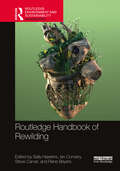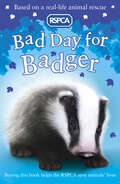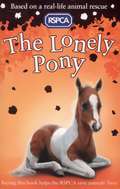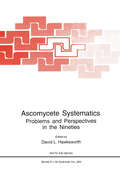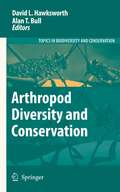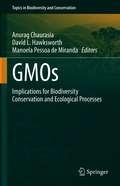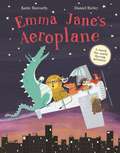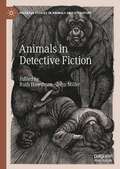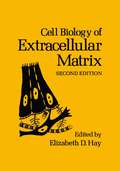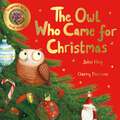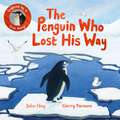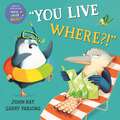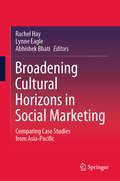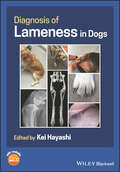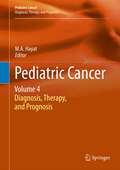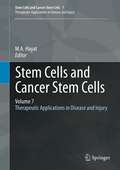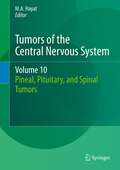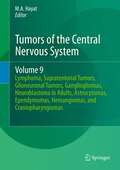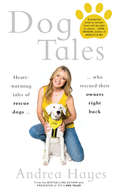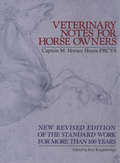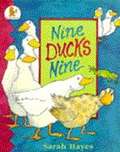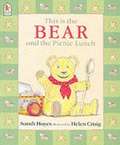- Table View
- List View
Routledge Handbook of Rewilding (Routledge Environment and Sustainability Handbooks)
by Sally Hawkins Ian Convery Steve Carver Rene BeyersThis handbook provides a comprehensive overview of the history, theory, and current practices of rewilding. Rewilding offers a transformational paradigm shift in conservation thinking, and as such is increasingly of interest to academics, policymakers, and practitioners. However, as a rapidly emerging area of conservation, the term has often been defined and used in a variety of different ways (both temporally and spatially). There is, therefore, the need for a comprehensive assessment of this field, and the Routledge Handbook of Rewilding fills this lacuna. The handbook is organised into four sections to reflect key areas of rewilding theory, practice, and debate: the evolution of rewilding, theoretical and practical underpinnings, applications and impacts, and the ethics and philosophy of rewilding. Drawing on a range of international case studies the handbook addresses many of the key issues, including land acquisition and longer-term planning, transitioning from restoration (human-led, nature enabled) to rewilding (nature-led, human enabled), and the role of political and social transformational change. Led by an editorial team who have extensive experience researching and practising rewilding, this handbook is essential reading for students, academics and practitioners interested in rewilding, ecological restoration, natural resource management and conservation.
Bad Day For Badger (Rspca Ser. #9)
by Sarah HawkinsWhen Lewis and his dad see an injured badger on the side of the road they call the RSPCA. But when the RSPCA arrive to examine the young badger,she scampers under a parked car, only to get well and truly stuck! The RSPCA must work with the Fire and Rescue team to try and free the baby badger, and Lewis is going to do all he can to help.
The Lonely Pony (PDF)
by Sarah HawkinsMia's mother is a groom at an RSPCA centre so she's used to looking after ponies. But when Polly arrives at the centre, underweight and frightened, Mia knows that this pony is going to need a lot of care and attention. At first Polly is too scared to go near humans, but Mia and her mother spend weeks gently nursing her back to health. With Mia's help, Polly will learn to trust again. An exciting, inspiring story based on a real-life animal rescue. With illustrations throughout and lots of facts about ponies and the RSPCA.
Ascomycete Systematics: Problems and Perspectives in the Nineties (Nato Science Series A: #269)
by David L. HawksworthProceedings of a NATO ARW held in Paris, France, May 11-14, 1993.
Arthropod Diversity and Conservation (Topics in Biodiversity and Conservation #1)
by David L. Hawksworth Alan T. BullThis collection of more than 30 peer-reviewed papers focuses on the diversity and conservation of arthropods, whose species inhabit virtually every recess and plane – and feature in virtually every food web – on the planet. Highlighting issues ranging from large-scale disturbance to local management, from spatial heterogeneity to temporal patterns, these papers reflect exciting new research – and take the reader to some of the most biodiverse corners of the planet.
GMOs: Implications for Biodiversity Conservation and Ecological Processes (Topics in Biodiversity and Conservation #19)
by David L. Hawksworth Anurag Chaurasia Manoela Pessoa de MirandaThis book covers a broad spectrum of topics related to GMOs and allied new gene-based technologies, biodiversity, and ecosystem processes, bringing together the contributions of researchers and regulators from around the world. The aim is to offer a clear view of the benefits and effects of genetically modified crops, insects, and other animals on the soil microbiome and ecological processes. Contributors examine issues related to the development of risk assessment procedures and regulations designed to maximize benefits while minimizing risks. Beyond the scientific challenges of GMOs, the book explores the broad and contentious terrain of ethical considerations. The contributors discuss such questions as the unintended, possibly unforeseen, consequences of releasing GMOs into ecosystems, and the likelihood that the full effects of GMOs could take years, even decades, of close monitoring to become evident. The importance of developing a precautionary approach is stressed. The final chapter describes the critical issues of governance and regulation of new and emerging gene-based technologies, as nations grapple with the consequences of adopting the Cartagena Protocol on Biosafety (CPB). The volume includes an extensive Annex which outlines legal perspectives on the state of GMO governance around the world, with more than 20 examples from nations in Africa, South and Central America, Asia, Australasia, and Europe.
Emma Jane's Aeroplane (PDF)
by Katie Haworth Daniel RieleyEmma Jane zooms off in her aeroplane around the cities of the world. Along the way she makes a crew of animal friends who save the day when the little plane gets into trouble... A rhyming narrative with a light touch and a zingy female protagonist, this tale is perfect for little explorers everywhere.
Animals in Detective Fiction (Palgrave Studies in Animals and Literature)
by Ruth Hawthorn John MillerThis book explores the vast array of animals that populate detective fiction. If the genre begins, as is widely supposed, with Edgar Allan Poe’s “Murders in the Rue Morgue” (1841), then detective fiction’s very first culprit is an animal. Animals, moreover, consistently appear as victims, clues, and companions, while the abstract conception of animality is closely tied to the idea of criminality. Although it is often described as an essentially conservative form, detective fiction can unsettle the binary of human and animal to intersect with developing concerns in animal studies: animal agency, the ethical complexities of human/animal interaction, the politics and literary aesthetics of violence, and animal metaphor. Gathering its 14 essays into sections on ontologies, ethics, politics, and forms, Animals in Detective Fiction provides a compelling and nuanced analysis of the central role creatures play in this enduringly popular and continually morphing literary form.
Cell Biology of Extracellular Matrix: Second Edition
by E. D. HayIn the ten-year interval since the first edition of this volume went to press, our knowledge of extracellular matrix (ECM) function and structure has enor mously increased. Extracellular matrix and cell-matrix interaction are now routine topics in the meetings and annual reviews sponsored by cell biology societies. Research in molecular biology has so advanced the number of known matrix molecules and the topic of gene structure and regulation that we won dered how best to incorporate the new material. For example, we deliberated over the inclusion of chapters on molecular genetics. We decided that with judicious editing we could present the recent findings in molecular biology within the same cell biology framework that was used for the first edition, using three broad headings: what is extracellular matrix, how is it made, and what does it do for cells? Maintaining control over the review of literature on the subject of ECM was not always an easy task, but we felt it was essential to production of a highly readable volume, one compact enough to serve the the student as an introduction and the investigator as a quick update on graduate the important recent discoveries. The first edition of this volume enjoyed con hope the reader finds this edition equally useful. siderable success; we D. Hay Elizabeth vii Contents Introductory Remarks 1 Elizabeth D. Hay PART I. WHAT IS EXTRACELLULAR MATRIX? Chapter 1 Collagen T. F. Linsenmayer 1. Introduction . . . . . . . . . . . . . . . . . . . . . . . . . . . . . . . . . . . . . . . . . . . . . . . . . . 7 2. The Collagen Molecule . . . . . . . . . . . . . . . . . . . . . . . . . . . . . . . . . . . . . . . . 8 2. 1. Triple-Helical Domain(s) . . . . . . . . . . . . . . . . . . . . . . . . . . . . . . . . . .
The Owl Who Came for Christmas
by John HayA heart-warming Christmas tale – inspired by an amazing true animal story.Christmas is coming, and the decorations are going up…But one family is about to discover an unexpected visitor snuggled up in their Christmas tree…A little owl called Rosie!The Owl Who Came for Christmas is the perfect gift for young animal lovers – and those who love incredible true animal stories. A read-aloud treat from John Hay and Garry Parsons, the illustrator of the bestselling Dinosaur That Pooped series.With facts about owls and the real events behind the story!
The Penguin Who Lost His Way: Inspired by a True Story
by John HayAn amazing true animal story about a brave little penguin.Hoppy the emperor penguin loves swimming in the sea with his friends. But one day Hoppy swims too far, and loses his way . . . ending up on a strange beach, all alone and far from home.How will poor Hoppy get back to his family?Inspired by the incredible true story of a lost little penguin, and the vets who saved his life, The Penguin Who Lost His Way is perfect for young animal lovers. From John Hay, and bestselling illustrator Garry Parsons.Includes a non-fiction spread with information about the real animal and the events behind the story.
You Live Where?!
by John HayA laugh-out-loud funny story. Perfect for fans of Kes Gray's You're Called What?! and Oi Frog and Friends.Little Snoring. Scratchy Bottom. Nowhere. Nowhere Else. You Live Where?!It's the first day of the holiday and down by the pool the birds are getting to know each other. But as they soon discover, they all have one thing in common… they come from places with the funniest names. Can you guess which bird comes from Chicken? And whoever comes from Duck? And who lives in Monster?A hilarious story, featuring a range of unbelievably odd place names from around the world - and they are all real! Includes some fun facts about all the birds and the places they come from. With illustrations from the artist behind the bestselling Dinosaur that Pooped series.
Broadening Cultural Horizons in Social Marketing: Comparing Case Studies from Asia-Pacific
by Rachel Hay Lynne Eagle Abhishek BhatiThis book presents a series of empirically based case studies conducted by social change scholars from Asia-Pacific, showcasing the latest social marketing approaches geared at improving societal well-being in the region. Cutting across cultural perspectives, the contents gather ideas on social marketing campaigns and strategies from around the region and use these case studies as a platform to address concomitant challenges in employing marketing tools to positively change social behaviour. The selection of case studies covers and compares aspects of public health and well-being, and public environmental consciousness in terms of driving attitudes towards implementing improved sustainability in developing and developed countries. Drawing on related policies and legislation, and examining social behaviour at the individual, community, and organisational levels, the authors propose innovative new methods in social marketing and social change research. The book is of interest to researchers and practitioners in social marketing, business ethics, behavioural science, public health, and development studies.
Diagnosis of Lameness in Dogs
by Kei HayashiDiagnosis of Lameness in Dogs Accessible and easy-to-understand step-by-step guide to the diagnosis of lameness in dogs Diagnosis of Lameness in Dogs provides general practice vets with a practical, step-by-step guide to performing the orthopedic diagnostic exam, including basic diagnostic imaging and advanced techniques such as CT, MRI, ultrasound, and arthroscopy, and arriving at a correct diagnosis. Treatment options are briefly summarized with the focus of the book being on diagnostics – because general practitioners will generally refer lameness cases. This book therefore provides guidance on possible causes of lameness and when to refer, and perhaps more critically, when not to refer. Overall, the text enables general practice veterinarians and veterinary students to develop confidence in accurately diagnosing causes of lameness. More than 600 color images depicting the procedures are included throughout the text. A companion website provides video clips of specific lameness conditions to aid in reader comprehension and information retention. Written by well-known orthopedic surgeons working in the area of lameness, Diagnosis of Lameness in Dogs also includes information on: General examinations, providing a systematic approach to the examination ensures that multiple problems are not missed Immediate steps to provide urgent care to severely traumatized dogs with hemorrhaging wounds and unstable/open fractures Systemic conditions, neurological disorders, and oncologic diseases that need to be ruled out before arriving at a diagnosis of the problem Specific conditions and diagnostic procedures for the thoracic limb, including bone disease, carpal/distal joints, the elbow joint, and the shoulder joint Specific conditions and diagnostic procedures for the pelvic limb, including bone disease, tarsal/distal joints, the stifle joint, and the hipar joint The first book to cover lameness diagnosis in detail, Diagnosis of Lameness in Dogs is a highly useful resource for veterinarians and students interested in improving their orthopedic diagnostic skills through gaining a foundation of relevant knowledge and an understanding of how to apply this knowledge in a field setting.
Diagnosis of Lameness in Dogs
by Kei HayashiDiagnosis of Lameness in Dogs Accessible and easy-to-understand step-by-step guide to the diagnosis of lameness in dogs Diagnosis of Lameness in Dogs provides general practice vets with a practical, step-by-step guide to performing the orthopedic diagnostic exam, including basic diagnostic imaging and advanced techniques such as CT, MRI, ultrasound, and arthroscopy, and arriving at a correct diagnosis. Treatment options are briefly summarized with the focus of the book being on diagnostics – because general practitioners will generally refer lameness cases. This book therefore provides guidance on possible causes of lameness and when to refer, and perhaps more critically, when not to refer. Overall, the text enables general practice veterinarians and veterinary students to develop confidence in accurately diagnosing causes of lameness. More than 600 color images depicting the procedures are included throughout the text. A companion website provides video clips of specific lameness conditions to aid in reader comprehension and information retention. Written by well-known orthopedic surgeons working in the area of lameness, Diagnosis of Lameness in Dogs also includes information on: General examinations, providing a systematic approach to the examination ensures that multiple problems are not missed Immediate steps to provide urgent care to severely traumatized dogs with hemorrhaging wounds and unstable/open fractures Systemic conditions, neurological disorders, and oncologic diseases that need to be ruled out before arriving at a diagnosis of the problem Specific conditions and diagnostic procedures for the thoracic limb, including bone disease, carpal/distal joints, the elbow joint, and the shoulder joint Specific conditions and diagnostic procedures for the pelvic limb, including bone disease, tarsal/distal joints, the stifle joint, and the hipar joint The first book to cover lameness diagnosis in detail, Diagnosis of Lameness in Dogs is a highly useful resource for veterinarians and students interested in improving their orthopedic diagnostic skills through gaining a foundation of relevant knowledge and an understanding of how to apply this knowledge in a field setting.
Pediatric Cancer, Volume 4: Diagnosis, Therapy, and Prognosis (Pediatric Cancer #4)
by M. A. HayatThis entry in the series Pediatric Cancer offers comprehensive information on a variety of cancers, concentrating on brain tumors, the most common solid tumors and the leading cause of cancer-related mortality in children. The contents are organized in seven sections: Neuroblastoma, Medulloblastoma, Leukemia, Lymphoma, Rhabdoid, Sarcoma and Miscellaneous Tumors. Coverage includes pediatric medulloblastoma, and treatments including craniospinal radiation followed by adjuvant chemotherapy. The contributors explain diagnosis and chemotherapy of children with acute lymphoblastic leukemia, and diagnosis of bone marrow involvement in pediatric lymphoma patients. Ewing’s sarcoma, a highly malignant connective tissue neoplasm formed by the proliferation of mesenchymal cells, receives extensive coverage, including targeting of molecular pathways and chemotherapy and surgical treatment. The roles of apoptotic genes, MYCN gene, MDM2, and SNP309, P13K inhibitors, alternative splicing and microRNAs, activated leukocyte cell adhesion molecule and inhibition by alu-like RNA in neuroblastoma are discussed in detail.The book explores the molecular genetics, diagnosis, prognosis and therapy of the atypical teratoid/rhabdoid tumor (AT/RT). Among the most common malignant neoplasms in children, AT/RT exhibits similarities with other CNS tumors, which can lead to misclassification, as pointed out in the book. The contributors discuss diagnosis of AT/RT type using imaging technology, and describe new strategies, including intensive multimodal therapy and high dose chemotherapy with autologous stem cell transplantation that have shown improved outcomes. Coverage of therapies includes total resection followed by aggressive chemotherapy and radiation. Discussion includes diagnosis and treatment of other pediatric tumors including adrenocortical tumors, supratentorial primitive neuroectodermal tumors, giant midline tumors, gastrointestinal stromal tumors, ependymomas and intramedullary cavernoma. Pediatric Cancer: Diagnosis, Therapy and Prognosis, Volume 4 includes contributions by ninety-one contributors - oncologists, neurosurgeons, physicians, research scientists and pathologists - representing thirteen countries. The editor, M.A. Hayat, is a Distinguished Professor in the Department of Biological Sciences at Kean University, Union, New Jersey, USA.
Stem Cells and Cancer Stem Cells, Volume 7: Therapeutic Applications in Disease and Injury (Stem Cells and Cancer Stem Cells #7)
by M. A. HayatThe seventh in Springer’s landmark series of edited volumes on one of the highest-profile subjects in contemporary medicine and scientific endeavour, this volume sets out to cover a staggering range of research into the medical applications of stem cell research. While stem cells are the very stuff of life for multicellular organisms, including us humans, the cancer stem cell is a morbid entity with a robust resistance to therapies including conventional chemotherapy. This authoritative publication explains the regenerative potential of stem cells and their mesenchymal progeny, reviewing clinical applications of the latter in the treatment of cancer, diabetes and neurodegenerative pathologies. It covers the entire range of stem cells with known potential for therapeutic use, from human embryonic to germ cell-derived pluripotent stem cells and hematopoietic stem cells. The chapters also deal with the role of TGF-beta in propagating human embryonic stem cells, and in facilitating their differentiation. Featuring discussions of molecular signaling pathways that modulate mesenchymal stem cell self-renewal and much more, this book is certain to have broad appeal among academicians and physicians alike.
Tumors of the Central Nervous System, Volume 10: Pineal, Pituitary, and Spinal Tumors (Tumors of the Central Nervous System #10)
by M. A. HayatAdding to a vitally important cycle of publications covering the latest research developments in our understanding of neoplasms affecting the human central nervous system, this edition focuses on numerous aspects of pineal, pituitary, and spinal tumors. As with the previous volumes in the series, this latest work addresses a central imperative in cancer research—the need to standardize classifications, written definitions and investigative guidelines in order to achieve a measure of shared objectivity among academics engaged in one of the most important medical endeavors of our era. It brings together the very latest work by oncologists, neurosurgeons, physicians, research scientists, and pathologists, providing the medical community with a wealth of data and results that, taken together, will advance the cause of cancer research. The volume synthesizes work on diagnosis, drug development, and therapeutic approaches that are typically scattered in a variety of journals and books. It features promising recent work in applying molecular genetics to clinical practice and evidence-based therapy, covering molecular profiling of tumors as well as a number of surgical treatments such as resection and radiosurgery. Together with its counterpart publications, it represents a much-needed central resource that will inform and guide future research efforts.
Tumors of the Central Nervous System, Volume 9: Lymphoma, Supratentorial Tumors, Glioneuronal Tumors, Gangliogliomas, Neuroblastoma in Adults, Astrocytomas, Ependymomas, Hemangiomas, and Craniopharyngiomas (Tumors of the Central Nervous System #9)
by M. A. HayatThe ninth volume in this essential series discusses key advances in our understanding of neoplasms in the human central nervous system. This publication deals with various aspects of nine separate types of brain tumors. With 70 contributors from 17 nations, this edition offers an unrivalled thoroughness and breadth of coverage that includes the very latest research results on the following tumor types: astrocytoma, lymphoma, supratentorial and glioneuronal tumors, gangliogliomas, neuroblastoma in adults, hemangioma, and ependymoma. The content introduces new technologies and their applications in diagnosis, treatment and therapy of tumors. It explains molecular profiling techniques that enable oncologists to select appropriate therapies for clinical trials, and discusses a number of surgical treatments, including resection and radiosurgery. Volume 9 is interspersed with color illustrations and tables depicting many of the results. This volume joins its fellow publications in a valuable series that fully explores controversies and debates in CNS cancer therapy, and furthers the scientific quest for effective therapies to combat cancer in all its forms.
Dog Tales: Heart-warming stories of rescue dogs who rescued their owners right back
by Andrea HayesWritten by Andrea Hayes, the presenter of TV3’s Dog Tales, these are the inspiring and heartwarming stories of fourteen rescue dogs who rescued their owners right back. Filled with touching stories of love, loss and transformation, Dog Tales will lift your soul as you laugh, cry and fall in love with these amazing animals.We meet Penny the Pit Bull, who was abandoned at her most vulnerable, but found happiness with a couple who take her everywhere – even to work. Read about Skittles, the terrified Shih Tzu, who was rescued from a puppy farm and found love and canine companionship in her new home. We also hear how a three-legged dog called Mick taught Andrea life lessons about living in the moment and thriving despite health challenges. ‘Andrea’s tender tales of human-canine connection will touch your soul and remind you of why dogs play such central roles in the lives of their human companions. Her passionate advocacy for those neglected, forgotten creatures their owners failed will make you want to open your heart and home to one of your own.’ John Grogan, author of Marley & Me
Veterinary Notes For Horse Owners: New Revised Edition Of The Standard Work For More Than 100 Years
by M. Horace HayesFor nearly 125 years, Captain Hayes' Veterinary Notes for Horse Owners has been the standard work on equine health care, constantly amended and updated. Leading veterinary specialists from Britain and around the world have been recruited to write this edition, the 18th, so it will continue to provide a totally comprehensive guide to horse medicine and surgery, explaining the symptoms and treatment of every disease or injury that the horse owner is likely to encounter. Written in plain language that both experts and novices will appreciate, the book contains detailed sections on the Organ, Musculoskeletal and Reproductive Systems, Infectious Diseases, Medical and Surgical matters, Management and Husbandry, and a variety of other important issues. New for this edition are section on Performance Analysis and Artificial Insemination. Clear, concise and authoritative, Veterinary Notes for Horse Owners saves horses lives.
Nine Ducks Nine (New edition)
by Sarah HayesSimple rhyming text and humorous speech bubbles are used to tell the story of nine ducks and the fun they have outwitting the hungry fox who is stalking them.
Nine Ducks Nine (New edition) (PDF)
by Sarah HayesSimple rhyming text and humorous speech bubbles are used to tell the story of nine ducks and the fun they have outwitting the hungry fox who is stalking them.
This is the Bear and the Picnic Lunch
by Sarah HayesThe boy, the bear and the dog are the best of friends. In This is the Bear and the Picnic Lunch, the boy prepares a picnic and leaves the bear in charge of it while he goes to find his shoes and socks. But guess who runs off with it while he's away?
This is the Bear and the Picnic Lunch (PDF)
by Sarah HayesThe boy, the bear and the dog are the best of friends. In This is the Bear and the Picnic Lunch, the boy prepares a picnic and leaves the bear in charge of it while he goes to find his shoes and socks. But guess who runs off with it while he's away?
